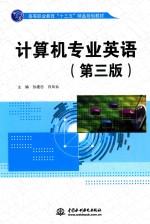

高等职业教育“十三五”精品规划教材 计算机专业英语 第3版PDF电子书下载
- 电子书积分:10 积分如何计算积分?
- 作 者:孙建忠,白凤仙主编
- 出 版 社:北京:中国水利水电出版社
- 出版年份:2016
- ISBN:7517046608
- 页数:226 页
Chapter 1 The History and Future of Computers 1
学习指导 1
1.1 The Invention of the Computer 1
1.1.1 The ENIAC 1
1.1.2 The UNIVAC I 2
1.2 Computer Generations 2
1.2.1 First-Generation Computers:1951~1958 3
1.2.2 Second-Generation Computers:1959~1963 3
1.2.3 Third-Generation Computers:1964~1970 4
1.2.4 Fourth-Generation Computers:1971~? 4
1.2.5 Generationless Computers 5
Reading Material: Classes of Computing Applications and Their Characteristics 6
科技英语的特点 7
Exercises 10
Chapter 2 Basic Organization of Computers 11
学习指导 11
2.1 Introduction 11
2.2 System Buses 12
2.3 Instruction Cycle 13
2.4 CPU ORGANIZATION 15
Reading Material: Eight Great Ideas in Computer Architecture 17
计算机英语专业词汇的构成 19
Exercises 23
Chapter 3 Binary System and Boolean Algebra 24
学习指导 24
3.1 The Decimal System 24
3.2 The Binary System 26
3.3 Boolean Algebra 26
数学公式的读法(Pronunciation of mathematical expressions) 28
Exercises 31
Chapter 4 Elementary Data Structures 32
学习指导 32
4.1 Stacks and queues 32
4.1.1 Stacks 32
4.1.2 Queues 33
4.2 Linked lists 35
4.2.1 Searching a linked list 36
4.2.2 Inserting into a linked list 36
4.2.3 Deleting from a linked list 36
4.2.4 Sentinels 37
Reading Material: Related Concepts 38
常用英汉互译技巧 40
Exercises 45
Chapter 5 Operating System 46
学习指导 46
5.1 OS Functions 46
5.1.1 Resource allocation and related functions 46
5.1.2 User interface related functions 48
5.2 FreeBSD vs.Linux vs.Windows 2000 49
Reading Material: RATs 52
被动语态的译法 54
Exercises 57
Chapter 6 Software Engineering 58
学习指导 58
6.1 Basic Software Concepts 58
6.1.1 Application Software 59
6.1.2 System Software 59
6.2 The Software Life Cycle 60
6.2.1 System engineering and analysis 61
6.2.2 Software requirements analysis 61
6.2.3 Design 61
6.2.4 Coding 61
6.2.5 Testing 61
6.2.6 Maintenance 62
6.3 Prototyping 63
Reading Material: Software Engineering Methodologies 64
长定语(从句)的翻译技巧之一 66
Exercises 69
Chapter 7 Programming Language 70
本章学习指导 70
7.1 Introduction to Programming Language 70
7.2 Object-oriented Programming 72
7.3 OMG's Unified Modeling Language(UML) 73
Reading Material: Programming Paradigms 75
长定语(从句)的翻译技巧之二 78
Exercises 81
Chapter 8The Internet 82
学习指导 82
8.1 The Internet: Key Technology Concepts 82
8.2 Other Internet Protocols and Utili Programs 88
8.3 Internet Service Providers 89
Reading Material: Transition from IPv4 to IPv6 91
英语长句的翻译 92
Exercises 96
Chapter 9 The World Wide Web 97
学习指导 97
9.1 Hypertext 97
9.2 Markup Languages 98
9.3 Web Servers and Clients 100
9.4 Web Browsers 101
Reading Material: Features of The Internet and The Web 102
学术论文的英文写作简介 107
Exercises 109
Chapter 10 Network Security 110
学习指导 110
10.1 Secure Networks and Policies 110
10.2 Aspects of Security 111
10.3 Responsibiliry and Control 111
10.4 Integrity Mechanism 111
10.5 Access Control and Passwords 112
10.6 Encryption and Privacy 112
10.7 Public Encryption 113
10.8 Authentication with Digital Signatures 114
10.9 Packet Filtering 115
10.10 Internet Firewall Concept 116
Reading Material: KINDS OF SECURITY BREACHES 117
科技论文标题的写法 118
Exercises 120
Chapter 11 Database System 121
学习指导 121
11.1 Overview 121
11.2 Database Models 123
11.2.1 Flat File 123
11.2.2 Relational 123
11.2.3 Hierarchical 124
11.2.4 Other Database Models 125
11.3 Data Mining 126
英文论文引言的写作技巧 127
Exercises 134
Chapter 12 Multimedia and Compuer Animations 135
学习指导 135
12.1 Multimedia 135
12.1.1 Visual Elements 136
12.1.2 Sound Elements 136
12.1.3 Organizational Elements 137
12.1.4 Multimedia Applications 137
12.2 Computer Animation 138
12.2.1 Design of Animation Sequences 138
12.2.2 General Computer-Animation Functions 139
英文摘要的写作技巧 140
Exercises 144
Chapter 13 Anatomy of the Internet of Things 145
学习指导 145
13.1 Traditional Internet Protocols Aren't the Solution for Much of the IoT 146
13.1.1 Introducing the “Chirp” 146
13.1.2 Functionality the IoT Needs—and Doesn't 147
13.1.3 Efficiency Out of Redundancy 148
13.2 It's All Relative 150
13.2.1 Format Flexibility 151
13.2.2 Private Markers for Customization and Extensibility 151
13.2.3 Addressing and “Rhythms” 152
13.2.4 Family Types 152
13.3 Applying Network Intelligence at Propagator Nodes 153
13.3.1 Transport and Functional Architectures 154
13.3.2 Functional Network Topology 156
13.3.3 Defined by Integrator Functions 156
13.3.4 Harvesting Information from the IoT 157
13.3.5 Programming and “Bias” 157
13.3.6 Receiver-Oriented Selectivity 158
求职英语简介 159
Exercises 162
Chapter 14 Cloud Computing 163
学习指导 163
14.1 Definitions 163
14.2 Related Technologies for Cloud Computing 165
14.3 Cloud Service Models 168
14.4 Cloud Deployment Models 169
14.5 Public Cloud Platforms: State-of-the-Art 170
14.6 Business Benefits of Cloud Computing 172
广告文体简介 173
Exercises 176
参考译文 177
参考文献 226
- 《全国高等中医药行业“十三五”创新教材 中医药学概论》翟华强 2019
- 《培智学校义务教育实验教科书教师教学用书 生活适应 二年级 上》人民教育出版社,课程教材研究所,特殊教育课程教材研究中心编著 2019
- 《MBA大师.2020年MBAMPAMPAcc管理类联考专用辅导教材 数学考点精讲》(中国)董璞 2019
- 《习近平总书记教育重要论述讲义》本书编写组 2020
- 《党员干部理论学习培训教材 理论热点问题党员干部学习辅导》(中国)胡磊 2018
- 《“十三五”规划教材 中药鉴定学实验 供中药学 药学及相关专业使用 第2版》吴啟南 2018
- 《办好人民满意的教育 全国教育满意度调查报告》(中国)中国教育科学研究院 2019
- 《教育学考研应试宝典》徐影主编 2019
- 《危险化学品经营单位主要负责人和安全生产管理人员安全培训教材》李隆庭,徐一星主编 2012
- 《21世纪法学系列教材 配套辅导用书 行政法与行政诉讼法练习题集 第5版》李元起主编 2018
- 《中国当代乡土小说文库 本乡本土》(中国)刘玉堂 2019
- 《异质性条件下技术创新最优市场结构研究 以中国高技术产业为例》千慧雄 2019
- 《中国铁路人 第三届现实主义网络文学征文大赛一等奖》恒传录著 2019
- 《莼江曲谱 2 中国昆曲博物馆藏稀见昆剧手抄曲谱汇编之一》郭腊梅主编;孙伊婷副主编;孙文明,孙伊婷编委;中国昆曲博物馆编 2018
- 《中国制造业绿色供应链发展研究报告》中国电子信息产业发展研究院 2019
- 《中央财政支持提升专业服务产业发展能力项目水利工程专业课程建设成果 设施农业工程技术》赵英编 2018
- 《中国陈设艺术史》赵囡囡著 2019
- 《指向核心素养 北京十一学校名师教学设计 英语 七年级 上 配人教版》周志英总主编 2019
- 《《走近科学》精选丛书 中国UFO悬案调查》郭之文 2019
- 《清至民国中国西北戏剧经典唱段汇辑 第8卷》孔令纪 2018
